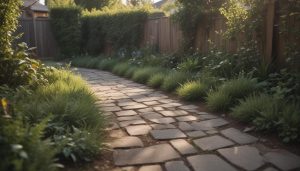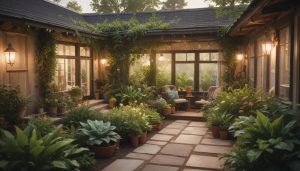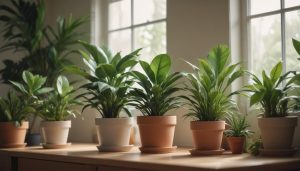You Can Create a Lush Low-Maintenance Garden
Daniel Fisher August 23, 2025
Considering a beautiful backyard but worried about the upkeep? Discover how low-maintenance landscaping, drought-tolerant plants, and smart garden design can help you achieve a lush, inviting outdoor space with less work and more enjoyment—all while keeping your garden sustainable and eco-friendly.
Understanding Low-Maintenance Landscaping
Low-maintenance landscaping is a smart approach, especially for busy homeowners who still want an inviting outdoor space. Instead of daily watering and frequent mowing, this style focuses on sustainable choices that require less attention and fewer resources. The key to a successful low-maintenance garden is strategic design—thinking ahead about plant placement, water needs, sun exposure, and ongoing care. With this mindful landscaping strategy, it’s possible to cut back on both labor and utility costs, while still enjoying a vibrant, healthy garden environment. Many people now seek creative landscaping ideas to make their yards more manageable without sacrificing beauty or curb appeal.
Central to this concept are drought-tolerant plants, perennial groundcovers, stone pathways, and mulched beds. By incorporating these elements, yards become easier to maintain and conserve resources like water and fertilizer. Landscaping experts often recommend grouping plants by their moisture needs and sunlight preferences to maximize their potential and minimize the need for intervention. In urban areas, this approach reduces stormwater runoff and supports pollinator habitats. Not only do these gardens look beautiful year-round, but they’re also designed for resilience and longevity.
Of course, adopting a low-maintenance style requires upfront planning. Factors to consider include climate zone, soil type, typical rainfall, and available light. Helpful resources such as Cooperative Extension services and botanical gardens offer guidance tailored to local regions. By focusing on environmentally friendly solutions and sustainable gardening techniques, homeowners create spaces that support both their lifestyles and the natural ecosystem. Over time, these thoughtful choices can even enhance property value while reducing annual maintenance efforts.
Choosing Drought-Tolerant Plants for Lasting Impact
Drought-tolerant plants form the backbone of many low-maintenance gardens. These species are adapted to thrive with little moisture and can withstand periods of dry weather with ease. Some favorites include lavender, yarrow, sedum, Russian sage, ornamental grasses, and succulents. These varieties offer lush textures and colorful blooms, even in challenging conditions. Homeowners are increasingly selecting drought-resistant varieties not just for water savings, but for their resilience and minimal pest problems as well (https://www.epa.gov/watersense/start-saving).
Plant selection should be based on your climate zone and the specific needs of your garden plot. For example, homeowners in arid regions might opt for xeriscaping, a style that emphasizes native plants like agave or sagebrush. Meanwhile, gardeners in more temperate areas may focus on deep-rooted perennials like coneflowers or echinacea. Consulting local guides or university extension resources can point you toward species well-suited for your location, ensuring healthy growth and less maintenance down the line. Mulching around these plants conserves moisture and suppresses weeds, further reducing upkeep requirements.
Another benefit of using drought-tolerant plants is habitat creation. Birds, bees, and butterflies thrive in gardens that integrate native and diverse flora. Not only does this improve the overall health and vitality of your outdoor space, but it also promotes local biodiversity. Pollinators are essential for productive vegetable gardens and prolific flower beds, so choosing plants that support them pays dividends all season. Emphasizing hardy, native species aligns with eco-friendly landscaping trends and makes gardens more self-sustaining year after year.
Smart Garden Design: Pathways, Beds and Borders
An efficient, visually appealing garden starts with thoughtful design. Begin by analyzing how you want to use your outdoor space—entertaining, relaxation, vegetable gardening, or play. Design principles such as defined pathways, raised beds, and well-planned borders help create structure, guide movement, and frame focal areas. Permeable pathways made of stone, gravel, or wood chips minimize maintenance and promote healthy drainage, reducing water pooling and potential mud zones. These elements add not just function, but also texture and contrast to the garden’s appearance.
When establishing garden beds, consider layering techniques and succession planting. Place the tallest and most drought-tolerant plants at the back or center of beds, gradually mixing in medium-height and groundcover species closer to the front. This approach reduces weeds and shades soil, conserving moisture and suppressing unwanted growth. Curved borders and organic shapes add natural flow, while grouping similar varieties creates visual unity. Leaving open space between beds or borders ensures that you can easily maintain the garden without trampling delicate areas.
Integrating low-maintenance garden edging, such as steel, brick, or recycled materials, helps define spaces and keeps mulch or gravel in place. These borders lower the risk of soil erosion and simplify lawn mowing around garden features. Additionally, installing drip irrigation or soaker hoses provides plants with precise moisture while minimizing evaporation. Together, these design choices build a flexible, attractive landscape that requires less work over time and adapts well to changing seasonal demands.
Eco-Friendly Practices for a Sustainable Backyard
Eco-friendly gardening principles are gaining traction, especially as communities focus on sustainability. Key practices include rainwater harvesting, composting, and choosing organic fertilizers. Installing rain barrels provides free irrigation for garden beds, lowering water bills and helping plants thrive during dry spells. Mulching with organic materials—such as leaf litter, straw, or compost—improves soil structure, retains moisture, and feeds beneficial soil organisms. This creates an environment where plants have the nutrients they need, naturally reducing the risk of disease and pests (https://www.epa.gov/soakuptherain/soak-rain-rain-barrels).
Supporting wildlife is another essential step. Backyard habitats benefit birds, pollinators, and small mammals by providing food, water, and shelter. Avoiding chemical pesticides and embracing integrated pest management allows natural predators—like ladybugs and birds—to control unwanted insects. Native plants often require less care and are less susceptible to problems because they’re adapted to local conditions. These green landscaping choices help improve soil health and air quality, making gardens both safer and more resilient in the face of climate shifts.
Consider installing solar-powered garden lighting or using recycled materials for garden structures. These upgrades reduce energy use and encourage reusing existing resources. For those committed to reducing their environmental impact, replacing thirsty lawns with native groundcovers or meadows saves time, money, and water. Sustainable landscapes offer beauty and tranquility—without the guilt of overconsumption. By adopting eco-friendly garden practices, people invest not only in their own space but also in the broader health of their communities.
Keeping Up With Minimal Effort: Seasonal Tips
One of the main draws of a low-maintenance garden is its seasonal adaptability. Set up your garden in spring by checking irrigation systems, applying a fresh layer of organic mulch, and pruning back perennial growth. This prevents unwanted weeds and minimizes the need for constant intervention. Pull weeds while they’re young, and inspect plants for pests or disease before they spread. A little bit of spring preparation can pay big dividends in saving time through the growing season.
In summer and early fall, it’s important to monitor moisture needs, especially for young or newly established plants. If you installed drip irrigation, check for leaks and adjust flow as needed. Older, drought-tolerant varieties typically thrive with just occasional deep watering. Deadheading spent flowers and trimming vigorous growers ensures a tidy appearance and encourages repeat blooms. Autumn presents an opportunity to plant bulbs or add layers of mulch to protect roots from winter freeze. Using seasonal tips like these can keep your garden flourishing with just a few scheduled tasks.
Finally, winter is a time for assessment. Review plant performance, move struggling varieties, and compost any garden debris to enrich the soil for next season. Leaving some stems and seed heads intact provides food and shelter for birds and beneficial insects during the colder months. A relaxed winter approach ensures that your low-maintenance landscape supports biodiversity while staying neat and welcoming, ready to burst into life once warmer days return.
Designing for Outdoor Living and Curb Appeal
For many, a home’s exterior is a place for gathering, relaxing, and entertaining. Incorporating patios, decks, or defined seating areas encourages outdoor living, extending the usable space of the home. Select comfortable, weather-resistant furniture and arrange it with views of beautiful plant groupings. Shade structures or pergolas offer protection from the sun and provide a frame for climbing vines and flowers—a functional, attractive way to add vertical interest.
Lighting is another key factor. Solar-powered path lights, lanterns, and spotlights highlight important garden features and make the space more inviting in the evening. Choosing hardscape elements—like gravel beds, decorative boulders, or raised planters—adds personality and structure without increasing the maintenance burden. Layering these elements in harmony results in a cohesive look, making curb appeal effortless and lasting for years to come.
A vibrant yet simple garden inspires guests and neighbors alike, but its greatest reward is the tranquility it brings to everyday life. By investing in a low-maintenance landscape that matches your lifestyle, you gain more time to enjoy your outdoor oasis and less time fussing with upkeep. With these tips and approaches, beautiful and sustainable outdoor living becomes accessible to anyone who wants to reclaim their weekends and relax in a space that truly feels like home.
References
1. U.S. Environmental Protection Agency. (2022). Garden and Landscape Maintenance for Water Efficiency. Retrieved from https://www.epa.gov/watersense/start-saving
2. National Gardening Association. (2021). Low Maintenance Landscaping. Retrieved from https://garden.org/learn/articles/view/634/
3. The Royal Horticultural Society. (2022). Drought-Resistant Plants. Retrieved from https://www.rhs.org.uk/advice/profile?pid=396
4. University of California Agriculture & Natural Resources. (2023). Sustainable Lawn Care. Retrieved from https://ucanr.edu/sites/scmg/Lawn_Care/
5. U.S. Environmental Protection Agency. (2023). Soak Up the Rain with Rain Barrels. Retrieved from https://www.epa.gov/soakuptherain/soak-rain-rain-barrels
6. University of Minnesota Extension. (2022). Creating Pollinator-Friendly Gardens. Retrieved from https://extension.umn.edu/planting-and-growing-guides/creating-pollinator-friendly-landscape







